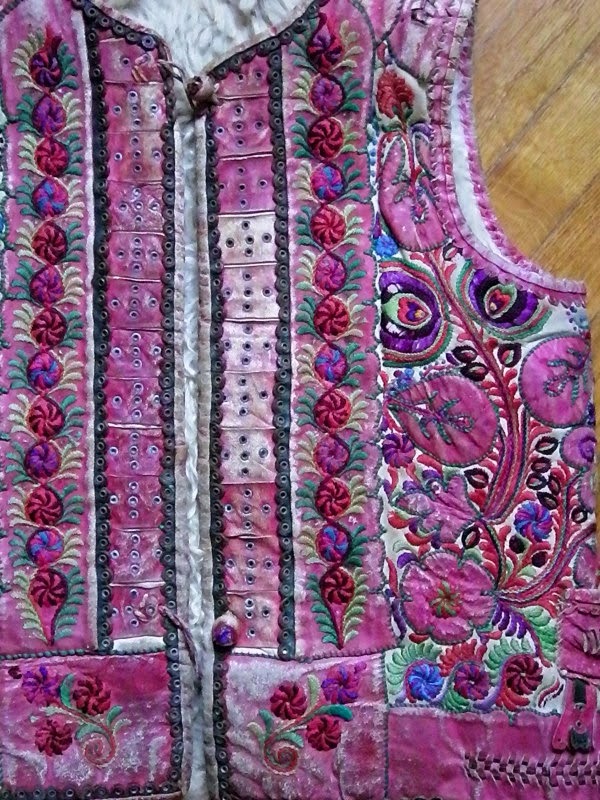Its a wonderful piece and a great reference in identifying embroidery.
Saturday, November 8, 2014
Hungarian Embroidery Sampler
Its a wonderful piece and a great reference in identifying embroidery.
Labels:
buszak,
hungarian embroidery,
hungarian folk art,
kalotaseg,
Matyo,
parna,
sampler
Monday, October 6, 2014
Monday, September 29, 2014
About Vintage Grain Sacks
Vintage linen grain sacks vary in weight, texture and weave, every piece is slightly different .
Most of our grain sacks date from before 1939, most are significantly older. Our grain sacks were woven in areas of Eastern Europe with a strong peasant culture. Families would grow their own hemp and or linen, harvest it, prepare for spinning and then weave. Hemp and linen was used to make clothes as well as household textiles and sacks and cart covers for use on the small holdings. Stripes and or monograms would indicate to the village mill whose grain was being milled. The most common coloured stripes are red or blue. We source from a small number of villages in transylvania where toffee coloured stripes were woven form thread dyed using walnut kernels. Hering bone weaves are more ommon in Romaina, sometimes thes fabrics are dark and very heavy and generally not as attractive as the fabrics thtat were made in hungary, the Ukraine and some of the Transylvanian villages.
Grain sacks are beautiful textured, versatile fabric. Measurements are for the unopened sacks . The sacks was made of one piece of fabric doubled over and hand stitched at the sides the opening hems. Some sacks have a triangular of rhombode peice of cloth inserted at the opening with which the sacks could be more easily grasped and may have been used as a pouring spout. Each grain sack is double the stated length if opened out.
Our pinterest page shows vintage grain sacks in use for furnishngs
Most of our grain sacks date from before 1939, most are significantly older. Our grain sacks were woven in areas of Eastern Europe with a strong peasant culture. Families would grow their own hemp and or linen, harvest it, prepare for spinning and then weave. Hemp and linen was used to make clothes as well as household textiles and sacks and cart covers for use on the small holdings. Stripes and or monograms would indicate to the village mill whose grain was being milled. The most common coloured stripes are red or blue. We source from a small number of villages in transylvania where toffee coloured stripes were woven form thread dyed using walnut kernels. Hering bone weaves are more ommon in Romaina, sometimes thes fabrics are dark and very heavy and generally not as attractive as the fabrics thtat were made in hungary, the Ukraine and some of the Transylvanian villages.
Grain sacks are beautiful textured, versatile fabric. Measurements are for the unopened sacks . The sacks was made of one piece of fabric doubled over and hand stitched at the sides the opening hems. Some sacks have a triangular of rhombode peice of cloth inserted at the opening with which the sacks could be more easily grasped and may have been used as a pouring spout. Each grain sack is double the stated length if opened out.
Our pinterest page shows vintage grain sacks in use for furnishngs
Friday, August 22, 2014
Antique blouses from the Kalotaszeg region of Romania
Wednesday, July 30, 2014
Textiles in Maramures
Maramures is an area in North East Romania, a valley surrounded by mountains it isnt easily accessible and has maintained traditions which have long since been lost in other areas.
Textiles are characterised by large bright woven patterns.
The area is famous for its wooden churches, many adorned with textiles, inside and out.
Here are some images taken in the region. With special thanks to Pensiune Anca where some of these images were taken (and where we had the most wonderful locally produced food) and The Village Hotel, Breb where we stayed in the most beautifully renovated house
Textiles are characterised by large bright woven patterns.
The area is famous for its wooden churches, many adorned with textiles, inside and out.
Here are some images taken in the region. With special thanks to Pensiune Anca where some of these images were taken (and where we had the most wonderful locally produced food) and The Village Hotel, Breb where we stayed in the most beautifully renovated house
Tuesday, April 29, 2014
Embroidered sheepskin waistcoat from Transylvania
-
- Mens sheepskin waistcoat, decorated with hand sewn cut leather appliqué stained pink and and pale cream, and coloured embroidery in red, green, purple, blue and pink wools..The waistcoat fastens with two leather buttons and loops, Decorated sheepskin coats, jackets and waiscoats were common in Transylvania and in some areas less highly decorated sheepskin jackets are still worn. I think that this waistcoat is from Hungarian Transylvania, the colours are beautiful and this piece shows an amazing skill and standard of workmanship. Its not in perfect condition, there is wear in some places
- Saxon Trasylvania in particular was well known for its furrier workshops in the 19th century. An embroidered sheepskin coat from Saxon Transylvania can be seen on the British museum website here
- Ref British Museum
Wednesday, April 2, 2014
Embroidered Mangle Board Cover
Lovely old cross stitch embroidered mangle board holder . This piece is from the Kalotaszeg region of Transylvania. Faded red cross stitch on hemp, this piece dates from the 19th century. In the days before irons and metal mangles wooden mangle boards were used to flatten linen. These wooden mangles were usually handcarved by young men, sometimes as gifts for their bride to be, they often had intricate carved designs and have become collectors items in their own right. There is more information on the history of the mangle board here
Subscribe to:
Comments (Atom)














.JPG)






































